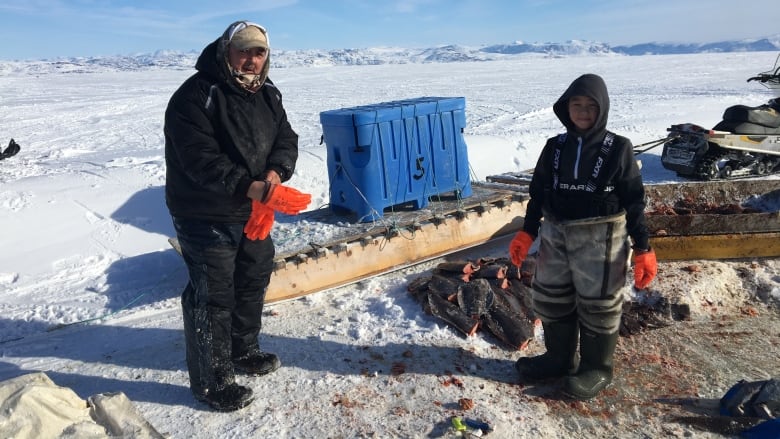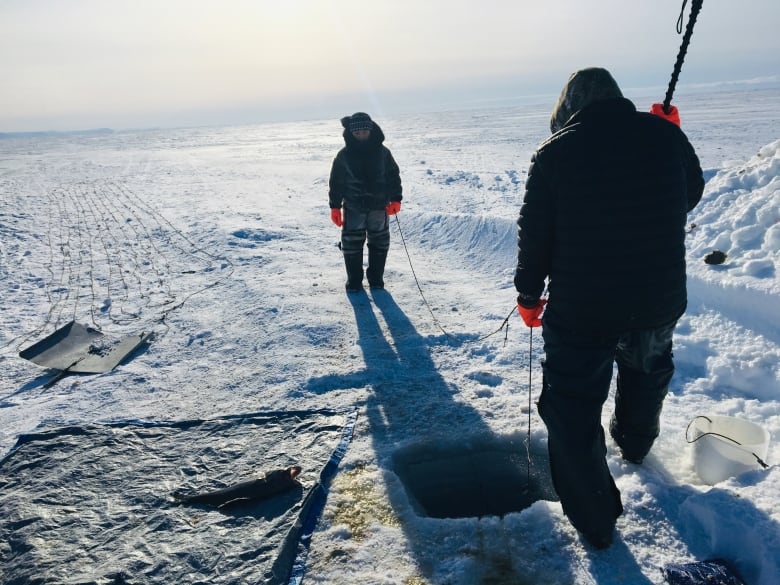Community in Arctic Canada seeks ways to grow thriving turbot industry

Every day and night in Pangnirtung, Nunavut from January to April, there’s a steady parade of snow machines leaving and arriving at the small craft harbour.
Fishers are hauling sleds with large plastic tubs, past the spectacular Pangnirtung Fjord enroute to Cumberland Sound. The tubs are empty on the way out, and often full on return with a product headed for Asia — flat, black Greenlandic turbot.
“We learned how to fish turbot commercially from Greenland fishermen. They’ve been fishing turbot for a long time,” says Peter Kilabuk, who’s brought his 11-year-old grandson Andrew to help him haul in today’s catch.
After about an hour-and a-half’s ride by snow machine onto the sea ice they get to their line. It’s time to haul in the catch. The line was set the day before with roughly 100 hooks baited by hand with Arctic char, and lowered steadily to the sea floor, a kilometre or so below the surface.
Kilabuk and Andrew power up a generator to control a winch which slowly winds the line.
One after another, Kilabuk unhooks the wriggling fish. Andrew pulls back the line to keep it taught.
“Occasionally we get bycatch,” said Kilabuk. “They go right back in.”
He says later in the spring, the fishermen can land unwelcome Greenland sharks.
“They make a mess of your lines if they get caught,” he said.
The turbot have white flesh, similar to halibut. They live and eat close to the sea bed, which has evolved their features. They have flat bodies, with one eye on the top of their heads and one on the side. Their large mouths have sharp teeth to eat anything they see.
Highest prices per pound in 30 years

Turbot is “very, very popular throughout the world,” according to Sakiasie Sowdlooapik, secretary treasurer of Cumberland Sound Fisheries, an all-Inuit-owned company which also owns and runs the Pangnirtung Fish Plant.
It’s lucrative too, for the 80 or so fishermen involved. Last year, they hauled in almost 500,000 kilograms of turbot in the winter inshore fishery. At a $1.35 per pound this past winter — the highest price in 30 years — that translates to roughly $1.5 million dollars circulating in the community.
On a good day, with lots of fish, without tangles or sharks on the line, a fisherman can make up to $1,000.
And it’s hard work. Sowdlooapik says fishermen can be out in –40 C weather to ensure they bring in their harvest. On this day Kilabuk and Andrew remove their sealskin parkas to bask in a relatively warm –20 C.
The commercial winter turbot fishery began about 30 years ago in Pangnirtung a few years after the seal and fur trade collapsed, according to Sowdlooapik. Four years ago, local Inuit shareholders bought out the Pangnirtung Fish Plant and its parent company, Cumberland Sound Fishery from the Nunavut Development Corporation. Now Sowdlooapik says, the company is beginning to turn a small profit.
Sowdlooapik hopes to grow that profit margin by lengthening the fishery season.
“We also have a vessel that can fish in the summer if we can get a summer turbot quota,” he said.
‘We’ve always hunted and fished for our food’
Back at Kilabuk’s fishing hole, the grandfather and grandson gut and load the fish into a large plastic tub. They pour seawater over the catch to keep it fresh.
When their work is done, they clear off the ice, straighten the line and pack the sled.
Then, they make their way back to the Pangnirtung fish plant to see what their catch is worth.
Kilabuk, an outfitter and former MLA, says turbot is not only important economically for his community, it is a way for Inuit to continue an important way of life.
“We’ve always hunted and fished for our food. It’s what Inuit know, and have done sustainably for as long as we have lived,” he said.
Related stories from around the North:
Canada: Canada invests $1.2 million to help solve mystery of dwindling char numbers in Arctic, Eye on the Arctic
Finland: What a Saami-led salmon rewilding project in Arctic Finland can teach us about Indigenous science, Eye on the Arctic
Greenland: Greenland Atlantic salmon catch numbers well above new quota, CBC News
Norway: Norwegian trawler arrested in northwest Russia for illegal fishing, The Independent Barents Observer
Russia: Norway and Russia agree to slash cod quotas in Barents Sea, The Independent Barents Observer
Sweden: Environmentalists seek solutions to ghost net problem in Baltic Sea, Radio Sweden
United States: U.S. gov clears path for genetically engineered salmon, Alaska Public Media



